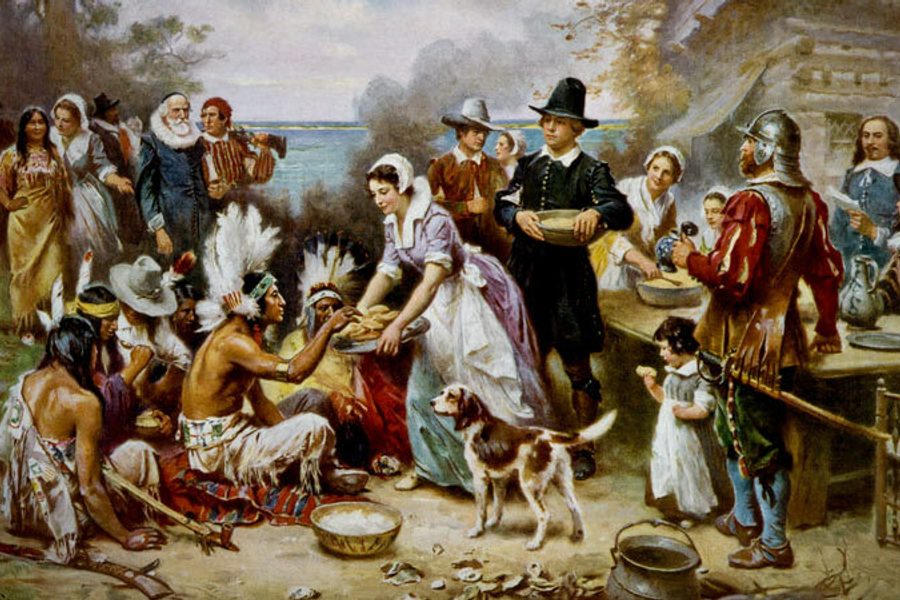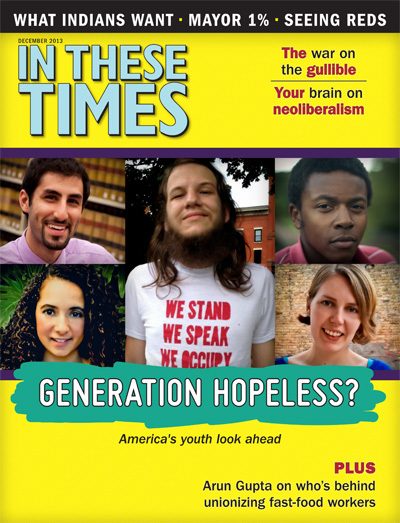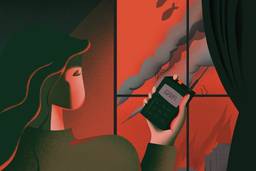
One hundred and fifty years ago, in the midst of the Civil War, Abraham Lincoln proclaimed Thanksgiving a national holiday. As part of his call to celebrate the day, Lincoln asked that the nation’s blessings be “solemnly, reverently and gratefully acknowledged as with one heart and one voice by the whole American people” and for Americans to “implore the interposition of the Almighty Hand to heal the wounds of the nation and to restore it as soon as may be consistent with the divine purposes.” Forged as a tool of national unity, the Thanksgiving narrative would prove over the next century-and-a-half to be an exceptional instrument for the task, becoming a cornerstone of America’s self-mythology.
Nevertheless, using “facts” to debunk the story of “the first Thanksgiving” is something of a cottage industry this time of year. Journalists, historians and talking heads across the political spectrum, in outlets from the Washington Post to the History News Network, argue over the historical accuracy of the tale. The debunkings often take the form of a bullet point list that contrasts historical “facts” with ahistorical “myths.” But these pundits fail to appreciate that the most compelling feature of the story is not its historic details, but its adaptability.
As the story goes, the Pilgrims came directly from England and landed at Plymouth Rock. In America, they hoped to find the freedoms and liberties denied to them by English authorities. After their first successful harvest, they invited a group of American Indians to help them celebrate Thanksgiving. Unlike the mercenary and abortive colonies of Jamestown and Roanoke, the Plymouth settlers are re- membered for their ideals (and their longevity).
A more historical account contends that when the Pilgrims left England and its church, they initially established a Separatist colony in Holland. But members quit the colony in its first decade, seduced by the “evil examples” of “extravagance and dangerous courses” exhibited by their Dutch neighbors. In need of an organizational and economic boost, the leaders uprooted the colony in 1620 and sailed across the Atlantic, landing first at Provincetown Harbor and settling eventually at Plymouth. Two primary sources, written by colonists William Bradford and Edward Winslow, provide the little detail we have of the actual ceremony that became the basis of Thanksgiving. We know that the Pilgrims brought with them the practice of celebrating a good harvest. They held one such festival at some point in the fall of 1621. During the feast, a group of Wampanoag appeared and stayed with them for several days.
There’s plenty, then, to quibble with in the traditional Thanksgiving story: The myth tells us that the Pilgrims landed at Plymouth Rock. The reality is that they first dropped anchor eighty miles away. The myth holds that the Pilgrims specifically invited the Indians to share a feast. Winslow’s account merely states there were “many of the Indians coming among us.” The myth tells us the settlers were seeking individual freedoms as we understand them — i.e., life, liberty, and the pursuit of happiness. But these ideals did not come along until the 18th century and were not enshrined in the national consciousness until 1776, with the signing of the Declaration of Independence. The Pilgrims came to America to preserve their numbers and improve their economic fortunes. They took a big risk to achieve modest and immediate goals.
Even the debunkings omit details, merge storylines and include a dizzying array of imaginative flourishes. Some confuse the Pilgrims, who were separatists, with the reformist Puritans, who landed further up the Massachusetts coast in 1630 to establish what became known as “the Massachusetts Bay colony.” After all, both begin with “P,” and the Puritans, too, held celebrations; the most famous (or infamous) of these was a gathering in 1637 to give thanks for the safe return of a group of soldiers from Connecticut and Massachusetts Bay, who, accompanied by Narragansett warriors, had massacred a group of Pequot as part of an ongoing war. Writers and historians who are displeased with the coziness of the Pilgrims’ 1621 episode often focus on the 1637 Puritans incident as a sort of anti-Thanksgiving foil.
The problem at the heart of the disagreement is that neither the Pilgrims nor the Puritans were celebrating Thanksgiving. They were just giving thanks. The historical facts of their giving thanks have since been rearranged and elaborated to create the story of Thanksgiving. To merely rely on “the facts,” then, won’t help us understand the significance of this story within our national mythology.
One of the most powerful features of the Thanksgiving story is its emphasis on unity — between different cultures, and between humans and God. Significantly, the Thanksgiving story was advanced when it was far from certain that a (re)union of North and South was possible. When Lincoln invited the nation to collectively “set apart and observe the last Thursday of November next, as a day of Thanksgiving and Praise to our beneficent Father who dwelleth in the Heavens,” he not only wanted to bind the nation together, but to bind the nation with the transcendent and eternal God of Christianity— a powerful seal indeed.
Unity remains elusive in America. The Atlantic/Aspen Institute’s 2013 American Values Survey reports that 61 percent of Americans believe the nation has become “somewhat more” or “much more” divided over the past 10 years, and a surprising 20 percent of the population is doubtful that the United States can remain united as one country. We’re divided by fault lines of race, religion, politics and class. Yet national traditions live on. Muslims, Jews, Hindus, Christians of all denominations, and even the separatist Amish celebrate these traditions in their own ways. For both religious and non-religious Americans, the spiritual unity embodied by the Thanksgiving story has been supplemented with new commercial and cultural practices — parades and football — that would likely surprise Lincoln. Thanksgiving has proven itself to be quite malleable and inclusive of most Americans, despite — or perhaps because of — its debatable origins.
Myths live and die, mutate and adapt, according to the interests of the societies that carry them. On an individual level, we cannot escape our collective myths because they are so personal. They are the glue that allows us to cultivate solidarity with others and make sense of our individual experiences. Though many Americans question whether we can remain one indivisible nation in a political sense, the civic practices of celebrating our unity, and the ways we incorporate the national myth into our own identities, remain strong. So this Thanksgiving weekend, as you drive on an interstate highway to visit relatives, spend a common currency at the mall, measure the weight of your turkey by United States customary units, or gather at the bar to watch the Cowboys or the Steelers, remember that unity in America is alive and well in the most routine, yet effluvial, ways.





